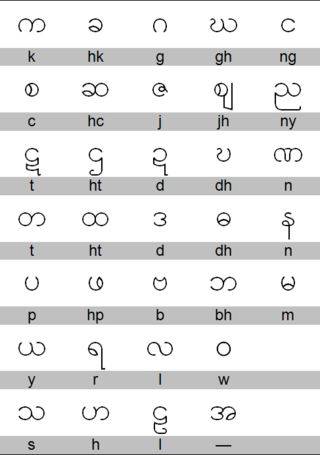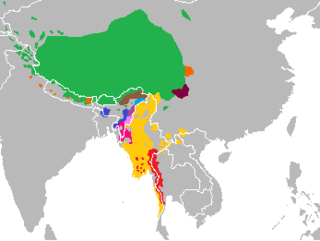Related Research Articles

Asia is home to hundreds of languages comprising several families and some unrelated isolates. The most spoken language families on the continent include Austroasiatic, Austronesian, Japonic, Dravidian, Indo-European, Afroasiatic, Turkic, Sino-Tibetan, Kra–Dai and Koreanic. Many languages of Asia, such as Chinese, Persian, Sanskrit, Arabic, Tamil or Telugu, have a long history as a written language.

The Tibetic languages form a well-defined group of languages descending from Old Tibetan. According to Nicolas Tournadre, there are 50 Tibetic languages, which branch into more than 200 dialects, which could be grouped into eight dialect continua. These Tibetic languages are spoken in Tibet, the greater Tibetan Plateau, and in the Himalayas in Gilgit-Baltistan, Ladakh, Aksai Chin, Nepal, and in India at Himachal Pradesh, and Uttarakhand. Classical Tibetan is the major literary language, particularly for its use in Tibetan Buddhist scriptures and literature.
The Ladakhi language is a Tibetic language spoken in the Indian union territory of Ladakh. It is the predominant language in the Buddhist-dominated district of Leh, and a minority language in the district of Kargil. Though a member of the Tibetic family, Ladakhi is not mutually intelligible with Standard Tibetan. Ladakhis and Tibetans usually communicate with each other in Hindi or English as they do not understand each other's languages clearly.
Tshangla is a Sino-Tibetan language of the Bodish branch closely related to the Tibetic languages. Tshangla is primarily spoken in Eastern Bhutan and acts as a lingua franca in the region; it is also spoken in the adjoining Tawang tract in the Indian state of Arunachal Pradesh and the Pemako region of Tibet. Tshangla is the principal pre-Tibetan language of Bhutan.
Khams Tibetan is the Tibetic language used by the majority of the people in Kham. Khams is one of the three branches of the traditional classification of Tibetic languages. In terms of mutual intelligibility, Khams could communicate at a basic level with the Ü-Tsang branch.

Lhasa Tibetan or Standard Tibetan is the Tibetan dialect spoken by educated people of Lhasa, the capital of the Tibetan Autonomous Region. It is an official language of the Tibet Autonomous Region.

There are approximately a hundred languages spoken in Myanmar. Burmese, spoken by two-thirds of the population, is the official language.

The Gyalrongic languages constitute a branch of the Qiangic languages of Sino-Tibetan, but some propose that it may be part of a larger Rung languages group and do not consider it to be particularly closely related to Qiangic but suggest that similarities between Gyalrongic and Qiangic may be from areal influence. However, other work suggests that Qiangic as a whole may in fact be paraphyletic, with the only commonalities of the supposed "branch" being shared archaisms and areal features that were encouraged by language contact. Jacques & Michaud (2011) propose that Qiangic including Gyalrongic may belong to a larger Burmo-Qiangic group based on some lexical innovations.

There are two dozen languages of Bhutan, all members of the Tibeto-Burman language family except for Nepali, which is an Indo-Aryan language, and the Bhutanese Sign Language. Dzongkha, the national language, is the only native language of Bhutan with a literary tradition, though Lepcha and Nepali are literary languages in other countries. Other non-Bhutanese minority languages are also spoken along Bhutan's borders and among the primarily Nepali-speaking Lhotshampa community in South and East Bhutan. Chöke is the language of the traditional literature and learning of the Buddhist monastics.

Baima is a language spoken by 10,000 Baima people, of Tibetan ethnicity, in north-central Sichuan Province and Gansu Province, China. Baima is passed on from parents to children in Baima villages. It is spoken within the home domain and is not used in any media of mass communication.
The Chhantyal are an indigenous people of Nepal. Chhantyals are considered an indigenous group by the Government of Nepal. Most of the Chhantyal dwellings are concentrated in the western part of the country. Baglung and Myagdi are two districts in the Dhaulagiri Zone where most of the Chhantyals are living. Other districts with Chhantyal habitation include Mustang, Gulmi, Rukum, and Parbat. Nowadays, owing to the migration trend there is a notable population of the Chhantyals in Kathmandu Valley, Pokhara, Rupandehi, Kaski, Dang and Chitwan districts. According to a survey conducted by its sole organization, Nepal Chhantyal Organization, the total population is 16,093 and 1,602 households. Traditionally Chhantyals have been living with other castes in harmony. In some villages Chhantyals are a major group whereas in other villages they are a minority. Chhantyals have their own culture, tradition, rituals, language, and religion.
Tibetan language may refer to:

The Tibeto-Burman languages are the non-Sinitic members of the Sino-Tibetan language family, over 400 of which are spoken throughout the Southeast Asian Massif ("Zomia") as well as parts of East Asia and South Asia. Around 60 million people speak Tibeto-Burman languages. The name derives from the most widely spoken of these languages, Burmese and the Tibetic languages, which also have extensive literary traditions, dating from the 12th and 7th centuries respectively. Most of the other languages are spoken by much smaller communities, and many of them have not been described in detail.
Central Tibetan, also known as Dbus, Ü or Ü-Tsang, is the most widely spoken Tibetic language and the basis of Standard Tibetan.
Magar Kaike is a Sino-Tibetan language of Nepal. Ethnologue classifies it as a West Bodish language.
Kyirong is a language from the subgroup of Tibetic languages spoken in the Gyirong County of the Shigatse prefecture, of the Tibetan Autonomous Region.
Gserpa is an eastern Tibetic language of Sichuan. It is spoken by a few hundred or thousand people in Sêrba District, Sêrtar County, Sichuan, China and is different from the Amdo Tibetan language, the dominant Tibetan language in the surrounding region.
The Dao language or Daohua is a Chinese–Tibetan mixed language or creolized language of Yajiang County, Sichuan, China. Word order is SOV as in Tibetan, while the lexicon consists of words derived from both Chinese and Tibetan.
Basum is a divergent Bodish language spoken by about 2,500 people in Gongbo'gyamda County 工布江达县, Nyingtri Prefecture, Tibet, China. Basum is spoken by 13.5% of the population of Gongbo'gyamda County. Glottolog lists Basum as unclassified within Bodish.
Tandrange is a Sino-Tibetan language spoken in a few ethnic Gurung villages of Lamjung District, Nepal. Tandrange is spoken in the villages of Tāndrāṅ (तान्द्राङ), Pokharī Thok, and Jītā (जीता). It belongs to the Greater Magaric branch of the Sino-Tibetan language family.
References
- 1 2 Tichurong at Ethnologue (25th ed., 2022)

- ↑ Tournadre, Nicolas; Suzuki, Hiroyuki (2023). The Tibetic Languages: an introduction to the family of languages derived from Old Tibetan. Paris: LACITO. ISBN 978-2-490768-08-0.